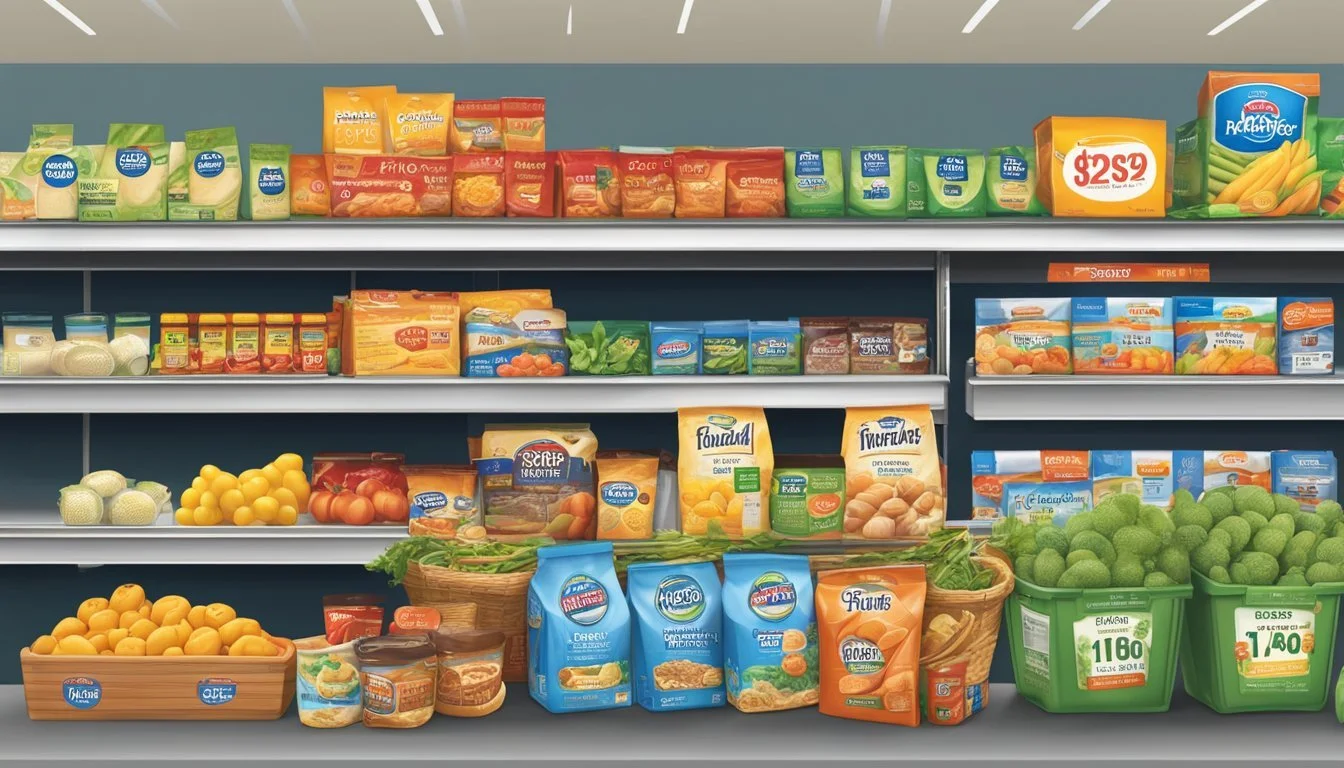Is Kroger Cheaper Than Hy-Vee?
Analyzing Grocery Pricing Trends
Part of Our Grocery Store Guide with Details on Kroger Prices and Hy-Vee Prices
Determining whether Kroger is cheaper than Hy-Vee involves considering various factors that influence grocery pricing, such as location, brand selection, and available discounts. Kroger, a large supermarket chain with an extensive online presence, competes closely with various other chains, including Hy-Vee in terms of pricing and the diversity of its product range. Reports suggest that Kroger's overall score is competitive, reflective of customer satisfaction and perceived value for money.
In contrast, Hy-Vee, with a narrower store footprint, frequently markets itself as offering top-notch customer service and quality products. While individual product categories may see Hy-Vee offering lower prices, such as on deli and meat products as evidenced in a comparison, a broader analysis across various grocery categories is necessary to draw a conclusive comparison. Shoppers often evaluate well beyond just sticker prices, considering factors such as loyalty programs, coupon policies, and the shopping experience itself when choosing where to buy groceries.
It is important for consumers to note that grocery prices can vary substantially even within the same chain, depending on the geographical location and prevailing local economic conditions. Thus, while some may find that Kroger offers more competitive prices, others may experience Hy-Vee as the more cost-effective option in their locality. The key to determining the better value will ultimately rest in the hands of the consumers, who weigh the balance between price, convenience, and quality.
Overview of Grocery Store Chains
In 2022, grocery store chains maintained essential roles in daily life, evolving operations to meet changing consumer needs. They ranged from budget-friendly options to premium markets, each offering distinct shopping experiences and product assortments.
Role of Grocery Stores in 2022
Grocery chains played a pivotal role in 2022 as key providers of food and everyday necessities. They included Kroger and Hy-Vee, which are prominent figures in the American grocery sector, along with Aldi known for its discount pricing, and Walmart and Target, which fused general retail with expansive grocery selections. Amazon's acquisition of Whole Foods underscored the growing trend of e-commerce in food retail, while chains like Trader Joe’s and Fresh Thyme appealed to niche markets with their curated product ranges. Meijer offered a hybrid model, combining grocery and department store elements under one roof.
Understanding Grocery Store Chain Operations
Grocery store chains operated complex supply chains to keep stores stocked. They worked to streamline purchasing, logistics, and inventory management to offer competitive pricing and variety. Kroger, for example, has developed a reputation for offering a wide assortment of goods, including its own store brands. Hy-Vee distinguished itself with an emphasis on customer service and health initiatives. These operations allowed chains to cater to diverse customer preferences, whether they sought the affordability of Aldi, the convenience of Walmart's one-stop-shop, or the specialty products from stores like Trader Joe's.
Price Comparison
In the competitive landscape of grocery retail, consumers often weigh the price disparities between leading chains. The section below elucidates findings from recent comparisons between Kroger and Hy-Vee, factors influencing pricing, and how to discern cost indicators when shopping.
Overview of Price Comparison Studies
Several studies have been conducted to assess where shoppers can get more for their money. A side-by-side comparison indicates Hy-Vee and Kroger offer distinct pricing models, often influenced by store location, available brands, and ongoing promotions. Researchers have used a comprehensive list of criteria to compare these supermarkets, evaluating factors like sale prices, store brands versus national brands, and price per pound. While one study suggested Hy-Vee showcases competitive pricing in specific categories, it's not always the clear-cut winner across all grocery items.
Variables Affecting Prices
Prices at retail chains like Hy-Vee and Kroger are not static and can be swayed by multiple variables:
Loss leaders: Products sold at a loss to draw customers in.
Quality of goods: Higher-quality items or organic options might command a higher price point.
Store brand vs. National brand: Store-brand items are typically less expensive than national brands.
Geographic location: Prices can vary considerably from one region to another. Data suggests that while one store might offer lower prices on specific goods, the other might undercut them on different items, leading to the importance of understanding these variables.
Understanding Price Tags
Consumers should become adept at reading price tags to make informed decisions. Checkout prices can involve more than the number on the tag, as additional savings can be available through:
Member discounts
Coupons
Special promotions Understanding the all-store average can aid shoppers in recognizing when they are getting a deal below the typical retail price. Advancements like consumer apps and podcasts like Consumerpedia offer insights into navigating these savings.
Product Categories and Quality
When comparing Kroger to Hy-Vee, it's important to consider the variety and quality of products offered in their respective stores, particularly in the produce, meat, deli, and dairy categories.
Produce Section Analysis
The produce section is a battleground for supermarkets, with both Kroger and Hy-Vee offering a range of fresh produce options. Shoppers looking for freshness typically gravitate towards ripe and vibrant fruits and veggies, including popular items like lettuce, blueberries, strawberries, potatoes, tomatoes, cucumbers, green bell peppers, and celery. While both stores strive to provide high-quality produce, Hy-Vee is often praised for its local sourcing strategies, which could give them an edge in the freshness of their fruits and vegetables.
Kroger: Known for regular promotions and deals on produce.
Hy-Vee: Focuses on local and seasonal produce, possibly enabling better freshness.
Evaluating Meat and Deli Offerings
The meat and deli sections are often gauged by the quality and range of products like chicken breasts, sausage gravy mix, and diced ham. Both Kroger and Hy-Vee offer a selection of meats that cater to various customer needs, from budget options to premium cuts.
Kroger: Competitive pricing across a broad selection of meat products.
Hy-Vee: Can offer specialty meats and a robust deli section, potentially with more exclusive items.
Dairy and Refrigerated Goods
Dairy items such as milk, eggs, and sour cream are staples in household refrigerators, and both Kroger and Hy-Vee feature extensive dairy sections. They endeavor to provide a blend of value and quality, presenting consumers with both brand-name and store-brand options.
Kroger: Typically offers a diverse range of dairy brands with occasional discounts.
Hy-Vee: May provide a unique selection of regional dairy brands and organic options.
Store Brands vs. National Brands
In the debate over store brands and national brands, shoppers often weigh the balance between cost and quality. This section explores the appeal of store brands, perceptions of quality, and how product offerings compare between Kroger and Hy-Vee.
The Appeal of Store Brands
Consumers are attracted to store brands—also known as private labels—for their lower price point. Kroger, for instance, offers its own range of such products under various labels. These often include generic staples priced below national brand equivalents. For example, Kroger's store brand may offer a loaf of white sandwich bread at a cost savings compared to a similar national brand product.
Perceptions of Quality
While national brands have historically been viewed as higher in quality, this perception is changing. Store brands have improved in overall quality, narrowing the quality gap with national brands. Consumers now find that store brands, like those carried by Kroger and Hy-Vee, can equal or exceed the quality of national brand offerings, particularly for everyday items such as raw chicken or pantry essentials.
Comparison of Product Offerings
The product offerings between store brands and national brands can vary. National brands may present a wider variety of flavors or specialty items, while store brands focus on the essential items with competitive quality. For instance, a survey revealed that Kroger's own brands are comparable in taste and quality to national brands, potentially offering consumers both quality and value as compared to competitors like Hy-Vee's store brands.
By offering products under their own labels, supermarkets like Kroger have positioned themselves competitively against other retailers such as Hy-Vee, leveraging a balance of quality and affordability. Store brands continue to gain consumer trust and market share, providing shoppers with a viable alternative to national brands.
Saving Strategies for Customers
When shoppers are looking for ways to save money at grocery stores like Kroger and Hy-Vee, they benefit from strategies that include identifying sale items, utilizing loyalty programs, and meticulously planning their grocery lists. By focusing on these areas, customers can find opportunities for savings even in the competitive pricing landscape of grocery retail.
Identifying Sale Items and Loss Leaders
Customers should pay attention to sale items and loss leaders at Kroger and Hy-Vee. Loss leaders are products sold at a loss to attract customers to the store, where they are likely to spend more on other items. Both Kroger and Hy-Vee feature weekly ads that list items with discounted prices. Shoppers can plan their purchases around these sale prices to reduce their overall bill.
Example of Loss Leaders:
Milk
Eggs
Seasonal produce
Leveraging Membership and Loyalty Programs
Both Kroger and Hy-Vee offer membership and loyalty programs that can yield substantial savings for customers. At Kroger, the Kroger Plus card allows shoppers to access lower prices and special promotions, while Hy-Vee offers the Fuel Saver + Perks program, where customers can save on gas and earn discounts on grocery purchases. Additionally, for those with an Amazon Prime membership, they can access Prime Member deals at stores affiliated with Amazon, like Whole Foods.
Loyalty Program Benefits:
Exclusive discounts
Accumulate points for future savings
Personalized deals
Creating a Smart Grocery List
A well-planned grocery list aligned with a meal plan can help customers save money. By listing items that are not only cheap but also healthy, shoppers can avoid impulse purchases and focus on items that are necessary for their weekly meal plan. Customers should incorporate sale items into their list and prioritize purchasing healthy food that also offers the best value.
Grocery List Planning Tips:
Incorporate sale and loss leader items
Prefer in-season produce for better affordability and freshness
Stick to the list while shopping to avoid overspending
Customer Experience and Convenience
In the competition between Kroger and Hy-Vee, customer experience and convenience play pivotal roles. Shoppers often judge these attributes through service quality and the availability of grocery delivery options.
Surveying Customer Service Ratings
Kroger and Hy-Vee invest significantly in customer service, training their personnel to ensure shoppers receive prompt and courteous assistance. Service ratings often feature on customer feedback platforms, including Facebook, where current buyers discuss their shopping experiences. Ratings reflect not only the in-store service but also the post-purchase customer support.
Kroger: Typically scores 3.5 to 4 stars on major review platforms.
Hy-Vee: Often ranges between 4 to 4.5 stars, reflecting a slightly higher satisfaction.
Exploring Grocery Delivery Options
Grocery delivery options have become a staple of the modern shopping experience. Kroger and Hy-Vee both offer various solutions to meet their customers' needs for convenience.
Kroger:
Partners with third-party services like Instacart for delivery.
Offers its own delivery solution in select locations.
Hy-Vee:
Provides Aisles Online, a comprehensive grocery delivery service.
Features time-slot reservations for greater customer control over delivery schedules.
Both retailers are continuously enhancing their delivery services to improve customer convenience, indicating their commitment to customer-centric innovation.
Case Study Comparisons
This section delves into the price discrepancies between supermarkets, specifically focusing on Kroger and Hy-Vee, and broadens the analysis to include comparisons with other major retailers.
Kroger vs. Hy-Vee Specific Analysis
Kroger and Hy-Vee are two prominent supermarket brands in the United States. An analysis comparing these stores based on price reveals Kroger may have a pricing edge on certain products. In contrast, Hy-Vee offers competitive prices but might be perceived as slightly more expensive overall in the online grocery space.
Kroger: Known for a wide range of products and competitive prices.
Hy-Vee: Prioritizes quality and customer service, which could reflect in pricing.
Comparison with Other Major Retailers
Walmart and Target are frequently identified as leading the pack in terms of price, alongside other cost-effective options like Aldi. These retailers have set a benchmark for low prices that both Kroger and Hy-Vee must contend with.
Retailer Average Price Comparison Notes Walmart 20% lower Known for undercutting prices of many competitors. Aldi Up to 50% savings overall Offers a no-frills shopping experience that passes savings to consumers. Target 11% lower Combines quality with competitive pricing strategies.
Whole Foods, on the other hand, often caters to a different market segment looking for premium and organic products, which generally command higher prices than conventional supermarket items.
Conclusion
When comparing grocery expenses, families, especially those with four members, can potentially save significantly by choosing stores with lower prices. A family spending $250 per week on groceries is often looking for the cheapest option while not compromising on quality.
Kroger is known for its competitive pricing structure and the availability of a generic store brand that offers savings on kitchen basics and shelf stable items. Their Kroger brand often undercuts prices on essentials like saltines, frozen foods, and canned goods. Hy-Vee, while providing a similar range of products, has been found to have slightly higher prices overall, but it still offers value through quality products and frequent promotions.
In terms of fresh vegetables, both retailers provide a selection that varies in price. However, shoppers looking for the absolute cheapest could lean towards Kroger based on general consumer feedback and price comparisons.
For consumers aiming to stretch their grocery dollars on a weekly basis, the choice may depend on the specific mix of items they purchase. Those heavily buying generic store brands and staples may find Kroger to be more cost-effective, while those who value Hy-Vee's store experience and brand mix might justify the marginal cost difference.
Finally, it's worth noting that prices can also be influenced by local competition and regional pricing strategies. Therefore, consumers are advised to monitor weekly ads and utilize customer loyalty programs to maximize their savings at either store.





